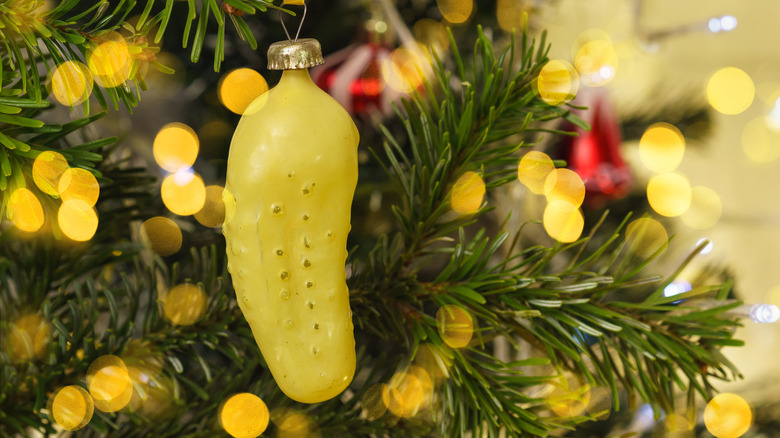The History Of The Christmas Pickle Ornament Tradition
You're in the holiday spirit, oohing and ahhing over magical glittering trees clad with tiny tin soldiers, cheeky little elves, and sweet-faced fairies and angels. Then suddenly, a quirky, curvy little green bauble appears, remarkably resembling a pickle. You do a double take, thinking you're mistaken, but finally realize that, yes, it's a pickle — hanging from a gorgeously decorated Christmas tree.
It's called a Christmas pickle, for obvious reasons, but it's no irreverent joke and not even a complete anomaly anymore. You'll find these festive vegetables in countless in-store or community Christmas displays, though they may not be immediately evident. That's because part of the Christmas pickle tradition is finding it buried within the evergreen branches amidst the more traditional dangling ornaments. According to the practice, it's the last ornament hung on the tree, and the first child to find it on Christmas morning, depending on the family, either receives a special gift or can expect good luck throughout the coming year.
Food-based ornaments for Christmas trees aren't necessarily a new idea, but the Christmas pickle is by far the most prominent one. However, it's far from a new marketing trick to grab attention. It actually has a story and a history, albeit a multifaceted one. The most prevalent tales of the Christmas pickle involve Germany, where the Christmas pickle tradition, known as Weihnachtsgurke, reportedly began. That story, however, raises a few eyebrows for authenticity, and it's certainly not the only origin tale of the Christmas pickle.
Dubious pickle tales from long ago
"New World" ornament-makers creating Christmas pickles relate the tradition to "Old World" Germany, a term that refers to time periods in Europe, Africa, or Asia prior to Christopher Columbus' journey to the Americas. Though the connections to old-world German traditions might be true, modern-day Germans are apparently a bit baffled by it. A YouGov survey conducted in 2016 revealed that only 8% of people in Germany are familiar with the Christmas pickle tradition and only 2% actually practice it by hanging a pickle ornament on their trees.
It seems to be more popular in America, especially amongst those with German or European heritage. Keepsake Christmas tree decorations from Germany are world-renowned, especially those from glass-making regions of East Germany, where glass ornament makers date back to the 1800s. This could be one reason why the German Christmas pickle connection is easily accepted as truth. However, another tale closer to home dates way back to the Civil War era. In this story, a German-American soldier, fighting for the Union in the war, fell ill from starvation after being captured. A prison guard took mercy and granted the soldier a pickle, which reportedly saved his life. The soldier then forever after decorated his tree with a pickle, every Christmas.
Those origin stories of the Christmas pickle definitely hold more sway than a third somewhat disturbing one involving two boys trapped inside a pickle barrel. At least they got rescued by good ol' Saint Nicolas.

